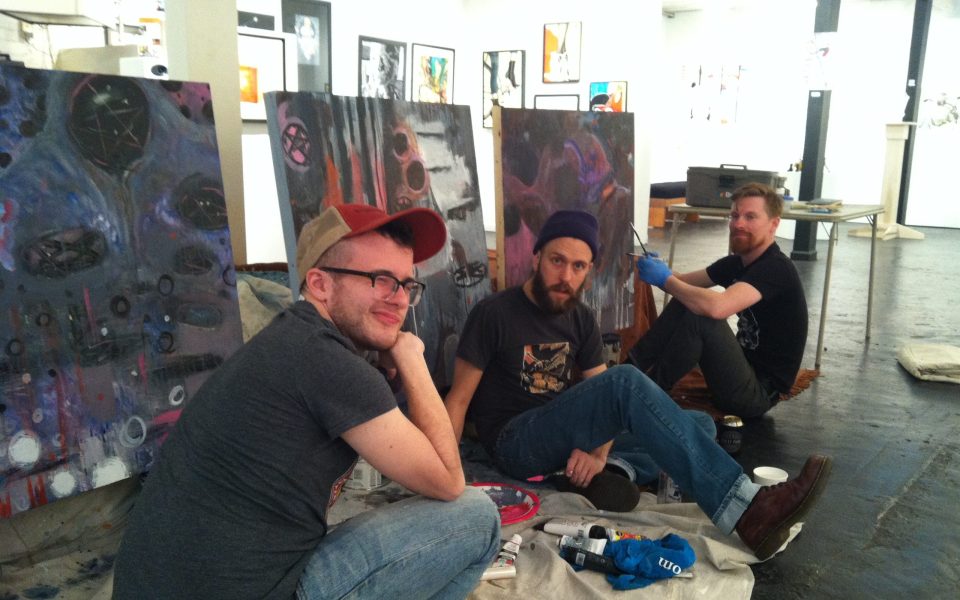Nectar. Amrita. Ambrosa. On the surface these words sound as if they are used to imply a type of soft angelic beauty. Nectar, conjuring images of the juice of sweet fruit, Ambrosa, a word that closely resembles ambrosia, a sweet white fluffy fruity concoction and Amrita can take one away to a beach sipping on fruity drinks out of pineapples with whimsical umbrellas. But in actuality these words are titles a collaboration of ominous images created by the hands of Dane Walters, Les Caison III and Lye Lawrence in their exhibit entitled Necro Nectar. And while there are lines of beauty that flow throughout their works, there is a definite theme of the dark, gruesome and macabre that cannot be overlooked.
“We were lined up in between those pillars,” Caison said as he points to the columns that surround the entrance of the exhibit, “with our canvas working on them and we had our own stuff.”
The three canvasses on the wall of the Delurk art gallery serve as the main entrance for the Necro Nectar exhibit on display in the gallery until Oct. 30. The wall, painted black by the artist themselves, displays the names of the collaborators in a dust of chalky white paint. The area also served as the space where the three pieces were created. A fitting resting place for their debut.
“We each created a 3 foot by 3 foot by 3-inch panel,” Caison said. “There were three of us. Three is a trilogy so there was kind of a theme.”
Each panel contains a different focus, but they all connect. Pentagrams grace each board and a likeness of a devilish creature can be found on at least two panels.
“We all started with the one [panel] we brought in and created this slow homogenization of colors that show up here,” Lawrence said.
Mixed in with shades of grays and blacks are overwhelming bursts of purples, pinks and teals, not colors one would often associate with the ghastly and morbid.
“I had, like, a white color pencil,” Caison said. “Dane [Walters] had, like, these markers that were very much acrylic paint with a marker tip that I had never used before. We all brought materials we were individually comfortable with. Then we started share each other’s materials which made for a wonderful collaboration.”
The middle panel, “Amrita,” features three glowing figures in the bottom right corner of the portrait. There’s no indication of whom the forms represent but it wouldn’t be off target to assume it is the mark of the artists whose minds traipsed along the boards.
Caison’s art is filled with images of devils falling from grace that are placed on soft pastel backgrounds surrounded by hearts reminiscent of sweetheart letters written to elementary school crushes. It’s hard to fear his angels of death despite their elongated fingers and outstretched wings that appear to be smeared with blood when they expose clean, subtle white breasts, sparklers for antennae, and pose against an otherwise untouched pallid background.
“I wanted to make sure there was still beauty involved,” Caison said, “So I put hearts in them to let people know that there was still the emotion of love occurring in the actions of falling from grace because they are still beautiful. [It’s about] creating that duality when two things that are happening at once and seemingly opposing.”
At the far end of the gallery, Walters displays what he calls his “necro zombies” in elaborately shaped frames that lend themselves to becoming part of the artwork itself. A golden curved beaded diamond frame houses the portrait of a zombie that appears to decay before the viewer’s eyes. His face, stitched together by tattered threads, are all that seem to prolong his existence. One almost feels sorry for the sorrow that flows from where is eyes used to be. However, throughout all the darkness there is an unknown source of light. Maybe it is a glimmer of what used to be human or the reflection of the gold frame bouncing off the canvas, but there is no fear for the creature, rather a longing to know more about him.
Not far from Walter’s work are Lawrence’s botanicals.
The effervescent colors Lawrence used in his collection of decomposing vegetation initially ensues a feeling of euphoria one would experience running through a field of sunflowers on a warm summer’s day. Upon moving closer to the work it is apparent that what the artist has actually drawn is a collection of rotting floral shedding teething, encapsulating additional molding plants, amidst a festering of multiplying eyeballs.
Although many utilize the month of October to exploit what many of the world fears, these three artist have found a way to celebrate the beauty within the darkest of objects.
“They are finding the beauty in what is considered morbid grotesque or decaying,” Lawrence said.
Join the First Amendment Society, a membership that goes directly to funding TCB‘s newsroom.
We believe that reporting can save the world.
The TCB First Amendment Society recognizes the vital role of a free, unfettered press with a bundling of local experiences designed to build community, and unique engagements with our newsroom that will help you understand, and shape, local journalism’s critical role in uplifting the people in our cities.
All revenue goes directly into the newsroom as reporters’ salaries and freelance commissions.


Leave a Reply